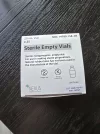Not trying to argue, but visual indications of contamination are only present when things get *really* bad. It's become clear in recent years that all kinds of contaminants are ending up in injectables from the stopper, and believe it or not, the glass, which is not inert.
The 2024 study linked to below demonstrates science is just starting to get a handle on this problem, trying to establish a testing protocol and establishing limits of contaminants. There have been incidents of contaminants from stoppers being identified as the cause of serious, even deadly reactions.
What we do have are materials that avoid this problem entirely. Coated stoppers (mentioned in the report) and glass lined with a quartz like coating to prevent boron and other chemicals from migrating into the liquid, as well as the steady delamination that fills the vial with glass shards.
If this sounds like far out tinfoil hat stuff, I can assure you it's part of mainstream pharmaceutical science now.
About 60% of US hospitals enacted policies requiring filtration of injectables in intensive care units. Those that have, reduced stays by an average of 1 day, because of a reduction in inflammation, organ failure, and other previously unexplained complications.
I know this isn't of interest to everyone, but some are interested in minimizing as much potential harm as possible, especially knowing small reductions over a long period can make a big difference. Most homebrewers say they do it because they don't trust UGLs to make safe products, so this is a step in that direction.
View attachment 296766View attachment 296767
Antonio Scatena, Scott Toth and Kyle Chenevert discuss the regulatory landscape regarding extractables and leachables for parenteral drugs and provide guidance on implementing a successful testing approach. Techniques and results interpretation are discussed, emphasising practical advice for...

ondrugdelivery.com











